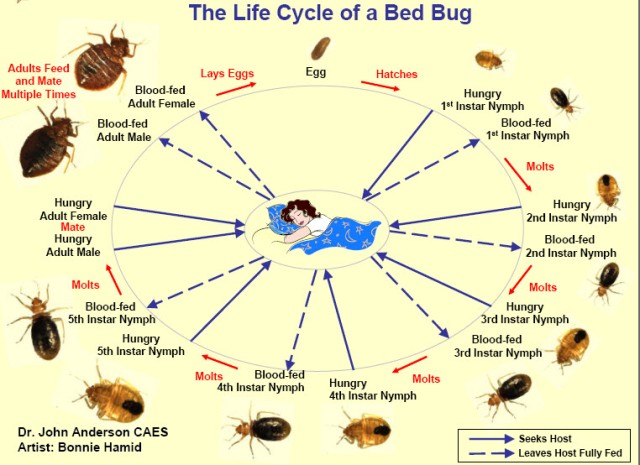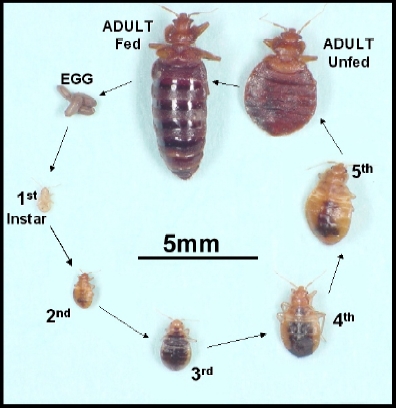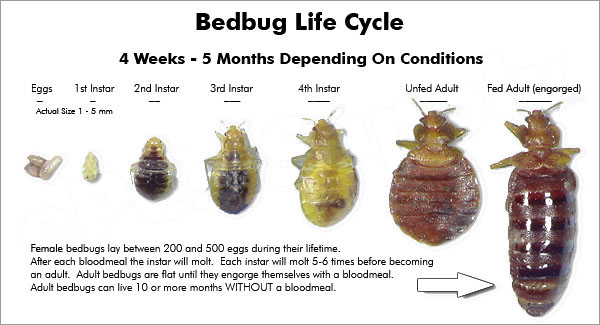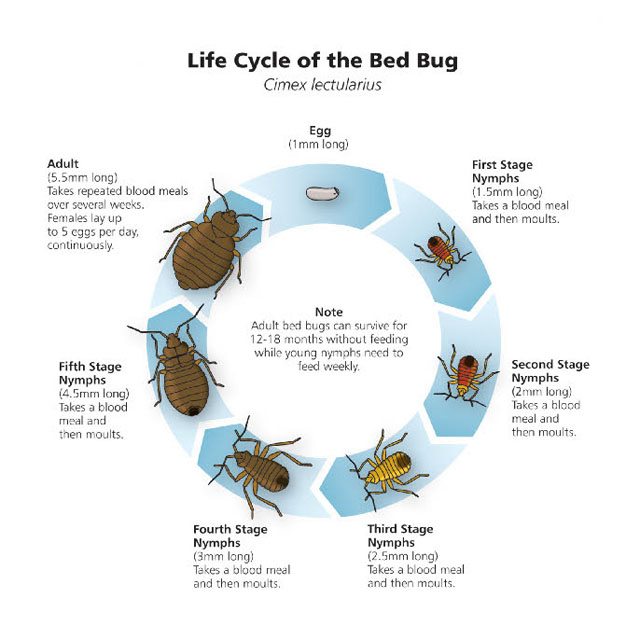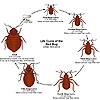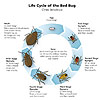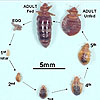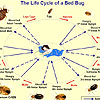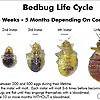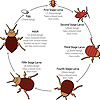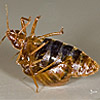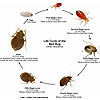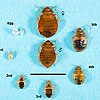Bed Bugs in Hotel
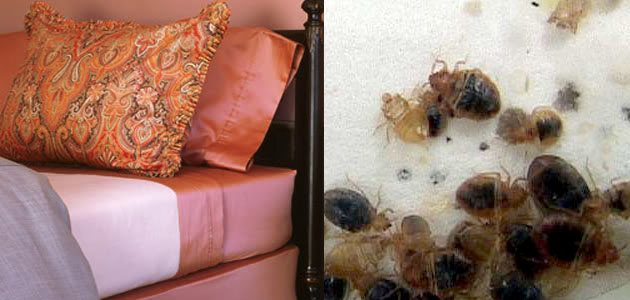
 Bed bugs are easy to transport in luggage and very hard to get rid of. For this reason they have become an especial nuisance for hotels, who are not eager to publicize their infestations. You can't tell whether a building or hotel room has them based on cleanliness - the bugs can thrive anywhere there are cracks and crevices to hide in. Bed bugs are becoming common in hotels, possibly because the bugs are developing resistance to sprays, or possibly because more toxic sprays have been outlawed. The bugs are showing up in luxury buildings and expensive resort hotels, so no one is immune to them. Bed bugs cannot fly, and you can kill them by encasing furniture or clothes in plastic; they need blood to live.
Bed bugs are easy to transport in luggage and very hard to get rid of. For this reason they have become an especial nuisance for hotels, who are not eager to publicize their infestations. You can't tell whether a building or hotel room has them based on cleanliness - the bugs can thrive anywhere there are cracks and crevices to hide in. Bed bugs are becoming common in hotels, possibly because the bugs are developing resistance to sprays, or possibly because more toxic sprays have been outlawed. The bugs are showing up in luxury buildings and expensive resort hotels, so no one is immune to them. Bed bugs cannot fly, and you can kill them by encasing furniture or clothes in plastic; they need blood to live.
AC_AX_RunContent( 'width','480','height','385','align','right','style','margin-left:5px;','src','https://www.youtube.com/v/w2J_i4t8i5s&hl=en_US&fs=1&','type','application/x-shockwave-flash','allowscriptaccess','always','allowfullscreen','true','movie','https://www.youtube.com/v/w2J_i4t8i5s&hl=en_US&fs=1&' ); //end AC code Before booking a hotel room, you may want to read user reviews of the particular hotel and location '” frequently, guests who've had bug problems report them online. Bear in mind that a report about one hotel does not mean the issue wasn't isolated to one room, or that hotel management hasn't since exterminated.
Still concerned? Concerned travelers may want to check their bed for telltale signs of the bugs, a more common practice years ago. Before jumping into bed, here are a few spot check tips:
- 1. Peel back the bed sheets and check the mattress, running your fingers along the upper and lower seams. Make sure to check the mattress tag, bed bugs often hide there.
- 2. Experts recommend removing and examining the headboard if possible. Check for tiny black spots (excrement) that are smaller than poppy seeds. You may also see translucent light brown skins or, in the case of an infestation'” live bugs.
- 3. Check the bedside table. Look for signs of bed bugs in the drawers and along the wall on the side of the bed that is less likely to be disturbed by cleaning staff and guests.
- 4. You may want to elevate suitcases and keep them off the floor, like on a luggage stand.
 5. If you see powder in the drawers or on the headboard, it is likely that the room has already been treated for bed bugs by an exterminator.
5. If you see powder in the drawers or on the headboard, it is likely that the room has already been treated for bed bugs by an exterminator.- 6. If bed bugs are detected, travelers should request for another room. Be sure to inform hotel management.
- 7. Just moving to a different room may not be the total answer. You should repeat the thorough inspection of any new or different room you are offered.
- 8. When you pack to leave, inspect your luggage carefully first, and inspect every item as you pack to help detect any bugs or their signs. Laundering most cloth items with typical hot water and detergent followed by drying on low heat for at least 20 minutes (or standard dry cleaning) should kill all bed bugs in or on such items. Sealing freshly-laundered items inside a plastic bag should help keep any more bed bugs from getting in those items later to hide (and be carried back with you).
AC_AX_RunContent( 'width','480','height','385','src','https://www.youtube.com/v/4Kk7i2eiufA&hl=en_US&fs=1&','type','application/x-shockwave-flash','allowscriptaccess','always','allowfullscreen','true','movie','https://www.youtube.com/v/4Kk7i2eiufA&hl=en_US&fs=1&' ); //end AC code
First, look into the cracks and seams of the mattress, as this is a favorite spot for bed bugs to hide. They sleep during the day, so are easy to spot at this time. If there are no bugs to be found, you should look for small rusty spots staining the mattress, as these stains could be the blood excrement of bed bugs. There may also be discarded exoskeleton shells near these stains, as bed bugs grow up to 5 times after a feeding, and shed often.
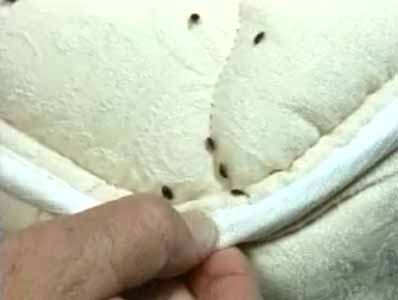 Blood excrement and exoskeleton shells are an indication of a bed bug brooding site, and if one brooding site exists, there are often more in the room. Next, look behind the head board of the bed and any nightstands that are in the area. Bed bugs have an affinity for wood, and are often found hiding in these areas. It is important to check these areas because the mattresses may have been cleaned, but the room could still be infested. Any bed bugs still alive after the bedding and mattress is treated will most likely be in these areas. They can not jump or fly, but can easily walk the distance from a night stand to your bed when you are asleep.
Blood excrement and exoskeleton shells are an indication of a bed bug brooding site, and if one brooding site exists, there are often more in the room. Next, look behind the head board of the bed and any nightstands that are in the area. Bed bugs have an affinity for wood, and are often found hiding in these areas. It is important to check these areas because the mattresses may have been cleaned, but the room could still be infested. Any bed bugs still alive after the bedding and mattress is treated will most likely be in these areas. They can not jump or fly, but can easily walk the distance from a night stand to your bed when you are asleep.
If you do find any bed bugs or brooding sites in your room, alert the staff immediately. Take your luggage with you also, because you don't want any of them hitching a ride and infesting your home. Hotels, motels, and hostels usually take bed bug infestations quite seriously and should be happy to move you to another room.
 Bedbugs (or bed bugs) are becoming an epidemic in hotel rooms throughout the United States. Larger cities, especially New York City are literally infested with them. Before staying in a hotel room for the night these days, it is best to spend five minutes and check the room for bedbugs. Some of the pictures of victims are downright gruesome. The bugs come in the night and bite along the thickest veins in your legs in the middle of the night where your slumber is at it's deepest level. Bedbugs are small black creatures, but you should be able to pick them out by following a few simple procedures. Here are some tips to and information on how to check for bed bugs around the hotel room.
Bedbugs (or bed bugs) are becoming an epidemic in hotel rooms throughout the United States. Larger cities, especially New York City are literally infested with them. Before staying in a hotel room for the night these days, it is best to spend five minutes and check the room for bedbugs. Some of the pictures of victims are downright gruesome. The bugs come in the night and bite along the thickest veins in your legs in the middle of the night where your slumber is at it's deepest level. Bedbugs are small black creatures, but you should be able to pick them out by following a few simple procedures. Here are some tips to and information on how to check for bed bugs around the hotel room.
1.Pick up the mattresses in the rooms and look under it. Check around the edges of the box springs.
2.Check under the box spring.
3.Look at the corners of the room. Oftentimes bedbugs are wedged in corners sleeping during the day. Also, spiders do catch them and this is where they generally have their webs.
4.This is the most important tip of all. Headboards in hotel rooms are easily removed. They are basically decorative. Lift up each headboard an lie it on the bed. Carefully inspect the hole where the headboard was lifted out of. Also, inspect all niches and corners of the headboard. Remember bedbugs are very small and dead bedbug husks sometimes can be hard to pick up. If you see any type of bug or husk of small bugs, you most likely have bedbugs in the room (or at least used to).















 Residence
Residence 


 Bed bugs and their relatives occur nearly worldwide. Bed bugs became relatively scarce during the latter part of the 20th century, but their populations have resurged in recent years, particularly throughout parts of North America, Europe, and Australia. They are most abundant in rooms where people sleep, and they generally hide nearest the bed or other furniture used for sleeping. Bed bugs are most active in the middle of the night, but when hungry, they will venture out during the day to seek a host. Their flattened bodies allow them to conceal themselves in cracks and crevices around the room and within furniture. Favored hiding sites include the bed frame, mattress and box spring. Clutter around the room offers additional sites for these bugs to hide, and increases the difficulty in eliminating bed bugs once they have become established.
Bed bugs and their relatives occur nearly worldwide. Bed bugs became relatively scarce during the latter part of the 20th century, but their populations have resurged in recent years, particularly throughout parts of North America, Europe, and Australia. They are most abundant in rooms where people sleep, and they generally hide nearest the bed or other furniture used for sleeping. Bed bugs are most active in the middle of the night, but when hungry, they will venture out during the day to seek a host. Their flattened bodies allow them to conceal themselves in cracks and crevices around the room and within furniture. Favored hiding sites include the bed frame, mattress and box spring. Clutter around the room offers additional sites for these bugs to hide, and increases the difficulty in eliminating bed bugs once they have become established.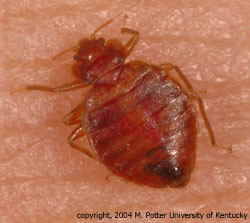
 Bed bugs are small, flat, oval, wingless insects (about one-fifth of an inch) that crawl at a steady rate and are visible to the naked eye. Similar to mosquitoes,
Bed bugs are small, flat, oval, wingless insects (about one-fifth of an inch) that crawl at a steady rate and are visible to the naked eye. Similar to mosquitoes, 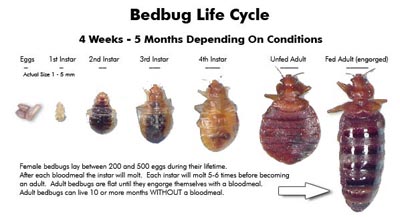
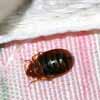 Here is some advice for you to avoid having bed bug bites. First, by covering up your body, you are helping to prevent bed bug bites. Bed bugs do not like to burrow under clothing. You may be able to avoid bed bug bites by wearing pajamas that cover up as much of your skin as possible. Secondly, it is important to note that if you are using insect repellents to keep bed bugs out, this will not help. Third, some have found that using mosquito netting that has been impregnated with permethrin, a pesticide, may help to protect you against bed bug bites while you are sleeping.
Here is some advice for you to avoid having bed bug bites. First, by covering up your body, you are helping to prevent bed bug bites. Bed bugs do not like to burrow under clothing. You may be able to avoid bed bug bites by wearing pajamas that cover up as much of your skin as possible. Secondly, it is important to note that if you are using insect repellents to keep bed bugs out, this will not help. Third, some have found that using mosquito netting that has been impregnated with permethrin, a pesticide, may help to protect you against bed bug bites while you are sleeping.  Bed bugs had been kept under control in most industrial nations in the last century with the development of appropriate pesticides. However, as people become more global in their travels and insects of all caliber become more resistant to chemical treatments, bed bug infestations have become common in some of the finest hotels and homes in the world. The good news is that bed bugs do not transmit diseases. They do, however, leave nasty welts or blisters where they bite, which later become red and itchy.
Bed bugs had been kept under control in most industrial nations in the last century with the development of appropriate pesticides. However, as people become more global in their travels and insects of all caliber become more resistant to chemical treatments, bed bug infestations have become common in some of the finest hotels and homes in the world. The good news is that bed bugs do not transmit diseases. They do, however, leave nasty welts or blisters where they bite, which later become red and itchy.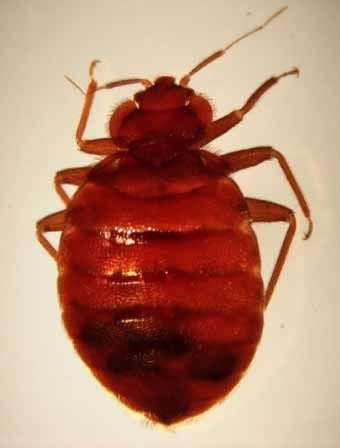
 They will reach their host either by crawling straight towards them, or climbing a wall and then across the ceiling until they feel a heat wave - when they jump down onto their host. The bug is attracted to the host by both its warmth and the presence of C02(carbon dioxide).
They will reach their host either by crawling straight towards them, or climbing a wall and then across the ceiling until they feel a heat wave - when they jump down onto their host. The bug is attracted to the host by both its warmth and the presence of C02(carbon dioxide).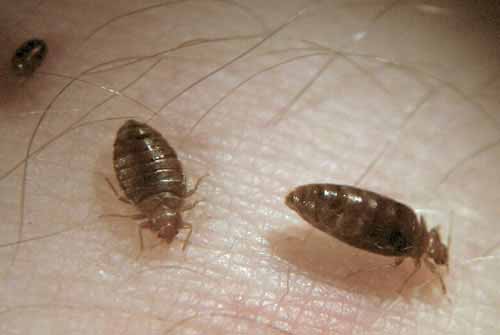 Bed bugs reproduce bytraumatic insemination, also known ashypodermic insemination. The males have hypodermic genitalia which pierce the females anywhere on their abomen and ejaculate sperm into the body cavity. The sperm diffuse through the insides and reach the ovaries, resulting in fertilization.
Bed bugs reproduce bytraumatic insemination, also known ashypodermic insemination. The males have hypodermic genitalia which pierce the females anywhere on their abomen and ejaculate sperm into the body cavity. The sperm diffuse through the insides and reach the ovaries, resulting in fertilization. When you are bitten a raised red bump of flat welt (also called a papule or a wheal) will appear, often accompanied by very intense itching. The anesthetic contained in the bed bugs saliva causes an allergic reaction which results in the red bumps. They look very similar to mosquito bites, but last a lot longer. Signs and symptoms of bug bites will only affect the surface of the skin.
When you are bitten a raised red bump of flat welt (also called a papule or a wheal) will appear, often accompanied by very intense itching. The anesthetic contained in the bed bugs saliva causes an allergic reaction which results in the red bumps. They look very similar to mosquito bites, but last a lot longer. Signs and symptoms of bug bites will only affect the surface of the skin.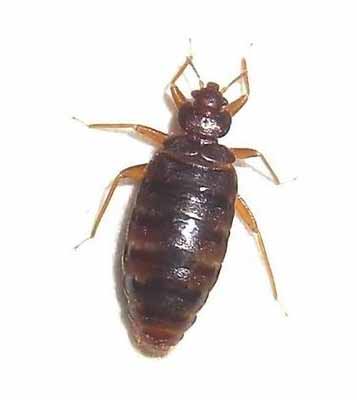
 In reference to the Don't Let the Bed Bugs Bite Act of 2008, Budget Travel asks, 'œShould taxpayers fund the war against bed bugs?' The Act, H. R. 6068, is now in consideration by the House Subcommittee on Commerce, Trade and Consumer Protection,and would primarily give states funding to inspect hotel rooms for bed bugs. Meanwhile, the bill Dale Mallory is sponsoring in the Ohio House of Representatives, which would establish a hotline where Ohio residents could report bed bugs or get information about them, and would require the Dept. of Health to educate the public about bed bugs, is also getting coverage from Cleveland NBC affiliate WKYC and in Vindy.com
In reference to the Don't Let the Bed Bugs Bite Act of 2008, Budget Travel asks, 'œShould taxpayers fund the war against bed bugs?' The Act, H. R. 6068, is now in consideration by the House Subcommittee on Commerce, Trade and Consumer Protection,and would primarily give states funding to inspect hotel rooms for bed bugs. Meanwhile, the bill Dale Mallory is sponsoring in the Ohio House of Representatives, which would establish a hotline where Ohio residents could report bed bugs or get information about them, and would require the Dept. of Health to educate the public about bed bugs, is also getting coverage from Cleveland NBC affiliate WKYC and in Vindy.com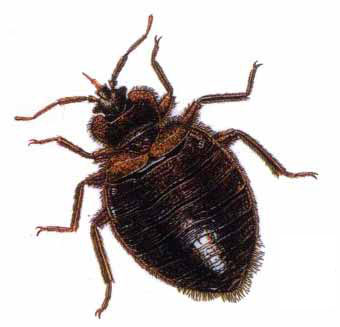 You might protest that bed bugs are not a danger to public health, but then the World Health Organization includes bed bugs in its new book, The Public Health Significance of Urban Pests. And the WHO not just includes bed bugs '” as Renee reminds us in an analysis of the WHO study over on New York vs. Bed Bugs, a bed bug is on the cover, with a tick and a rat. The WHO is concerned about the public health significance of bed bugs. Ohio, along with other states (and cities and countries) should be concerned too.
You might protest that bed bugs are not a danger to public health, but then the World Health Organization includes bed bugs in its new book, The Public Health Significance of Urban Pests. And the WHO not just includes bed bugs '” as Renee reminds us in an analysis of the WHO study over on New York vs. Bed Bugs, a bed bug is on the cover, with a tick and a rat. The WHO is concerned about the public health significance of bed bugs. Ohio, along with other states (and cities and countries) should be concerned too.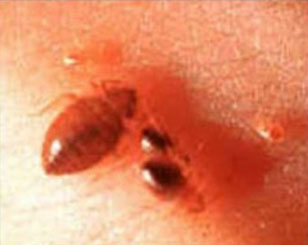 'œPeople move a lot,' she said. 'œIf they move from an infested [apartment] unit, they take their bedbugs with them. Now we get calls from people in single-family dwellings, which we didn't use to get.'
'œPeople move a lot,' she said. 'œIf they move from an infested [apartment] unit, they take their bedbugs with them. Now we get calls from people in single-family dwellings, which we didn't use to get.' Mallory, the state legislator, had never even seen a bedbug until leaders from the Cincinnati Council on Aging told him the insects were biting incapacitated seniors.
Mallory, the state legislator, had never even seen a bedbug until leaders from the Cincinnati Council on Aging told him the insects were biting incapacitated seniors. A few bed bugs can become a large infestation quickly. One female bed bug may produce up to 500 offspring during its lifetime, and three generations can live per year. Imagine how many bed bugs you'd have in a year if just one reproductive pair finds its way into your home. As with any pest, knowing its life cycle will help you eliminate it.
A few bed bugs can become a large infestation quickly. One female bed bug may produce up to 500 offspring during its lifetime, and three generations can live per year. Imagine how many bed bugs you'd have in a year if just one reproductive pair finds its way into your home. As with any pest, knowing its life cycle will help you eliminate it.